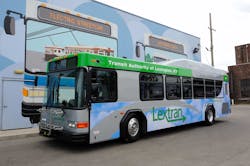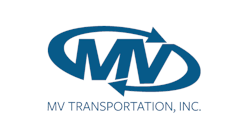Service Highlights
Service Area:
67 Square Miles
290,263 Population
2,268,839 Service Miles FY2013
Transit Service:
67 Fixed-Route Vehicles
5 Trolleys
22 Bus Routes
2 Trolley Routes
86 Bus Shelters
980 Bus Stops
FY2013 Budget Revenue
67% Local Tax Revenue
17% Federal Funds
8% Passenger Revenue
6% Other Income
2% State Funds
FY2013 Budget Expenses
52% Wages & Fringes
20% Paratransit
9% Fuel
7% Professional Services
6% Materials & Supplies
5% Other
1% Utilities & Phone
Today a retired lieutenant colonel from the Air Force, Lextran General Manager Rocky Burke got his start in public transportation after he got back from active duty in 1988 as a logistics officer. He applied for a job at Capital Metro in Austin, Texas, as its director of maintenance and as he said, “Surprisingly, after a national search they hired me … It was a real stretch of them to hire someone with no transit experience.” He stated, “When I started my public transit career, it was a direct result of experience in the Air Force.”
He started as the director of maintenance and worked his way up to acting GM of Operations. In 1994, he went to Sun Tran in Tucson, Arizona, as director of maintenance, working for ATE. His first job as a general manager was in Jackson, Mississippi, working for McDonald Transit. Transit there was funded directly out of the general fund from the city and like in so many places, most of the money went to fire, EMS, those types of services. “I think we had more vehicles sitting on the out of service order than we had in service,” Burke said of when he started there.
“Turned that around, refurbished a lot of buses using a company out of California because we didn’t have the money to buy new ones.” He said, “I did that for two and a half, maybe three years and learned a lot because we didn’t have much, so you really struggled along.”
After that he worked on the private side, with Prevost as its West Coast manager and when he was looking to move back to Texas, went to work for TransCoach until he was called to active duty during the Gulf War.
“When that was all said and done, there was not really a job left for me at Trans so I was looking for a job, hoping to work for the police department in Austin, Texas,” Burke said. He worked there for about seven years as its fleet and equipment manager. “I was there and happy and got a phone call one day from folks in the transit industry. They said we know you’re from Kentucky and the job in Lexington is open for a GM, would you be interested?
“I said sure and about seven years ago landed here in Lexington and have loved every minute of it. It’s been really challenging but a lot of fun,” said Burke.
His next stop is Sarasota County Area Transit (SCAT) in Sarasota, Florida, working directly for the county as of December 29, 2014. “I’ve taken the job as the director of transit for Sarasota County,” Burke said. “It’s a transit system a little bit bigger than what we have here but not by much. Not working for a contractor anymore but working directly for the county.”
Coming on to Lextran to fill the general manager role is Carrie Butler. “I’m from Louisville, Kentucky,” she said, “and have worked at the Transit Authority of River City and have been doing consulting for a number of different agencies, one of which was Lextran.”
An employee of Transdev, Butler had been working on a technology project and its surveillance system. “It made a nice transition,” she said, “I really know a lot of the back-end systems, as well as the staff and the management team having worked on that project.” She stated, “That’s made the transition a little smoother.”
Burke said, “I would say that’s one of the benefits of an agency contracted with a management service. It helps my attention to resign and taking this new job.” He continued, “Inside of a week Transdev was able to reach out to some internal applicants, to external applicants, reviewed resumes and within a week was able to present Carrie to our board of directors. They stepped up quickly to make this a smooth transition.”
Past Experience
One of the things Burke enjoyed about his experience at Capital Metro was the flexibility and freedom to start the compressed natural gas program there. There was a mandate from the state that they had to have so many of their government fleet vehicles in alternative fuel.
While “public-private partnership” is somewhat of today’s buzzword, said Burke, he said back in the day you never really thought about it. “We partnered with a local gas provider and just a great relationship,” he said.
A couple of years ago, he said a couple board members came to him and asked what he thought about going to CNG for the fleet. “I said it’s a great idea but you know, it costs quite a bit to do that, the infrastructure and all,” said Burke. “But it’s a great time to be considering because we’re building a new facility,” he added.
“From way back when, that CNG experience really has helped,” he said. And the private sector experience has helped, as well. “What I learned from that, how do you operate the public transit system like it’s a business?” he explained. “People that I run into over the years feel like they’ve got an endless supply of money and not necessarily operating it as efficiently as they should.
“Even though I’m not in the business to make money and everything’s subsidized, still I think it’s important to operate as efficiently as you can.”
Consolidation
The facility that they are in was built in the 70s and when Burke came to Lextran, he said they had 75 buses and a peak of around 60 everyday yet in the maintenance garage, there were only two fully functioning bays. “Mechanics were working on buses out in the parking lot and sending all of our non-revenue vehicles off site for repair,” Burke said.
Burke said they knew they needed to plan to grow the system and they had some grant money set aside to start the planning process. In September 2013, Lextran purchased land at the site of the former GE Lighting Glass Plant for the site of its future consolidate operations and maintenance facility. The official groundbreaking took place on December 9, 2014 and completion is expected in late 2016.
The new facility will house all operations, maintenance and administrative staff and facilities and the maintenance garage will have 7 bays to do more on-site repairs and a full line of maintenance. It’s a $26 million project and Burke said they’ll have about 54,000 square feet under roof. The 2-story administration building will handle all administrative staff and the first floor will be dedicated to a really nice day room for operators with showers, lockers, workout facility and quiet rooms. “The things you would typically expect in a nice facility,” Burke said.
The site of the facility is an old brownfield site. “GE went in and cleaned it up really nice and went in and made sure it was environmentally safe and did all those kinds of things and got the state to declare it a brownfield site,” Burke said. “I can’t imagine what else that site would be used for. Just a great partnership with GE and the community has embraced this, to put our facility over there.
A project manager was brought on that was an architect, very familiar with the LEED certification process and Burke said they anticipate achieving LEED Silver on this project. “Very proud of that,” he said. “When we talk about it, we make sure people know that.”
“This is only about an eighth of a mile from where we are today so it won’t disrupt our bus service or our routes. We’re excited about that,” Burke said. “…in 2016 we’ll move in to that new facility, so it’s a good time for us here.”
Design-Build Option
Instead of a design-build-bid, Burke said they opted for a design-build project delivery to save money and to do things a bit quicker. The project manager is URS Corp., the construction company is Lancer Commercial Construction of Lexington, Kentucky, and the architect is Maintenance Design Group (MDG). Burke said of MDG, “I was familiar with them, worked with them a little bit when I was at Capital Metro in Austin and worked with them on a project up in Fort Worth.
“One of the reasons we chose that design-build team was they were the only ones that actually went out and did some research and brought along one of their subs, Maintenance Design Group, who has gone around the country designing public transit facilities, specifically maintenance projects around the country.” He added, “They’ve really helped us with a lot of the design.”
There was $11 million coupled together from a couple of different grants, Burke explained. After the started the project, the project expanded and they found the land and it went from $11 million to about $26 million. “That became a bit of a financing challenge for us, but we had the grants.”
One of the other sources of revenue for the project was New Markets Tax Credit. Burke said they partnered with a community development entity in Lexington, Community Ventures Corp. “At the end of the day with all these New Market Tax Credits we’ve acquired, we’re going to net about $3.5 million that we normally would have had to borrow. That’s helped a lot.”
To be undertaking such a large project, staff visited other sites. One Burke mentioned was South Bend Public Transportation Corp. (Transpo). “They had a similar experience being built on an old automobile factory site and they have LEED certification as well,” he said. “And they’re about the same size as ours.”
Transpo’s Emil “Lucky” Reznik Administration, Maintenance and Operations Facility opened in 2010 and is certified LEED Platinum. Forum Architects LLC led the design team for the project that included MDG and RNL Design.
While there aren’t concrete plans for CNG at the new facility – other than they know they will have it – the plan as it stands today is to issue an RFP for a turn-key operation. “We don’t have a tremendous amount of capital,” Burke explained. “It will cost us a little bit more for the fuel doing it that way, but at the same time, there’s savings to it.
“We’re going to let someone come in to train all of our employees, both operators and maintenance. They will provide the compressors, fuel stations and maintain all the equipment for us,” said Burke. “As we grow the fleet.”
As it’s planned right now, they will have a design that will provide public access for the CNG so a person can pull up off the street on their property and use the CNG, charging a nominal fee. Burke said, “We’re trying to be good partners out in the community.”
Technology Update
Up until about three years ago, Burke said the system had “absolutely zero technology.
“We had mechanical drop boxes, we had no APC/passenger counters, no GPS, no nothing,” he stressed. With funding from the American Recovery and Reinvestment Act, they turned that around.
“We use the Avail system now with our AVL, GPS, passenger counters, electronic GFI fareboxes, all these kinds of things,” said Burke. “A big part of the AVL/GPS project was the digital signage to see how the public would react with our next-departure information.”
They’ve also placed new bus stop signs with a phone number to call to get exact information on when the next bus will be arriving. Lextran Director of Community Affairs Jill Barnett said the use of that system has grown as expected. There was a soft roll out when the system came online and gradually, the number of calls increased. “We now average about 40,000 per month,” she said.
She also said, “After a few months of that being online, we noticed a decrease in the number of calls that come to our customer service room.” Burke said, “It been very well accepted by everybody.”
The APC also allows them to check ridership against what’s coming through the farebox. And, in addition to that, “The NTD folks let us use that instead of doing all that manual sampling,” Burke said. “That’s helped us a lot. But the biggest thing has been the AVL/GPS piece of this thing allowing us to improve our on-time performance and passengers out there knowing where their bus is.
“If they have to wait, they understand that but if used to be they had to wait and had no clue where the bus was,” he said.
“The Avail folks have been really good at holding our hand through this process. We’re kind of on our own with it know, if you will,” explained Burke. He said thinking back, it probably was about 24 months before they felt like they really understood it, got the best value out of it. “If an agency went to this, give yourself at least two years to get it all fully operational. We’re probably still not perfect at it by any means, but I feel good about the data that I’m getting now.”
Arts in Transit
When asked about some of the things he’s most proud of, of his time at Lextran, Burke mentioned the art at the stops. When he came to Lextran, some discussion was already taking place.
“I thought it would be pretty cool to do public art in our shelters,” said Burke. “We had a little bit of money early on … the first of the three were done relatively inexpensively.” Currently there are five that went through the whole Art in Motion process and two that are really close to being funded through CMAQ.
Art in Motion Inc. is a non-profit organization in Lexington, Kentucky, that looks to create a vibrant city through the fusion of public art, public transit and public spaces. It enhances the bus shelters, incorporating murals and sculpture.
One of the neighborhood association leaders came to Lextran saying they wanted one of the “cool art shelter” in their neighborhood. Burke said they’ve got a location that would be great and the bank there that they approached to help pay for it. “We went out to the bank in town where the location was. They agreed it would be pretty cook; that’s how it got its piggybank theme.
Tthe Art in Motion project, I’m really proud of that,” he stressed. During his time at Lextran he said ridership has been good and they did a rebrand of the system, changing the logo and color scheme of the buses. I swore to our staff that I didn’t ever want to see another white bread box going down the street while I was here.”





